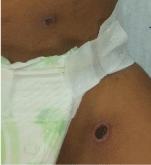
Case Summary
Austin Pediatr. 2019; 6(1): 1068.
Eschar: A Key to Diagnose Scrub Typhus
Sekhar J* and Meena P
¹Department of Pediatrics, University of Delhi, India
*Corresponding author: Jerin C Sekhar, Department of Pediatrics, Maulana Azad Medical College and associated Lok Nayak Hospital, University of Delhi, India
Received: March 24, 2019; Accepted: April 19, 2019; Published: April 26, 2019
Case Summary
A 4 year female presented with skin lesions that began as vesicles 13 days before admission and evolved to blackish lesions, fever for 11 days, oliguria with edema for 2 days and melena for 1 day. There was history of stay in a rural place and play with pets till 2 weeks prior to onset of illness. She was pale with tachycardia (120/min) and hypotension (70/50mmHg). There were painless black lesions with an erythematous rim on the left thigh, over the left iliac fossa and on the right hypochondrium (Figure 1,2). She had splenohepatomegaly, non-tender axillary and left inguinal lymphadenopathy and bilateral pleural effusion. Laboratory investigations revealed anemia (hemoglobin-8.7g/dL), normal leucocyte counts (10000/mm3, 30% polymorphs), thrombocytopenia (40000/mm3), pre-renal acute kidney injury (urea-166, creatinine-1.2), mild transaminitis (SGOT/ SGPT-50/84 IU/ml) and hypoalbuminemia (2.4g/dL).

Figure 1: Eschars seen in the right hypochondrium, left iliac fossa and left
thigh.

Figure 2: Black eschars with an erythematous rim.
A diagnosis of scrub typhus was made in view of the characteristic eschar. The child was initially stabilized with fluid boluses, inotropes and blood products. Doxycycline was started at 5 mg/kg/day. Her hemodynamic status improved dramatically and she became afebrile in 3 days. Malarial antigen, Dengue serology and Widal titers were negative. Blood and urine cultures were sterile. Weil-Felix test was positive in serum at a dilution of 1:160 for OX K, while OX 2 and OX 19 were negative. IgM ELISA for scrub typhus was positive. She was given doxycycline for 6 days and discharged. On follow-up two weeks later, hepatosplenomegaly and lymphadenopathy had regressed.
Scrub typhus, caused by Orienta tsutsugamushi and transmitted by chiggers of trombiculid mites, is an important cause of acute febrile illness in South East Asia and the Pacific. The clinical presentation described here and the eschar are keys to early diagnosis and initiation of treatment, thereby reducing mortality and morbidity.